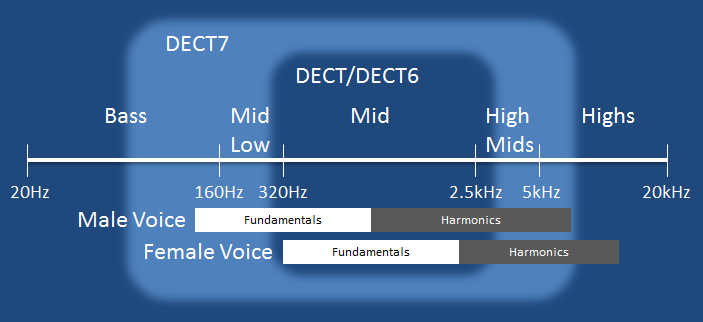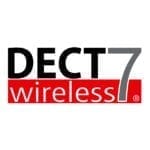WHAT'S IN THE HEADSET?
 Noise Reduction Rating (NRR)
Noise Reduction Rating (NRR)
Sonetics headsets feature an EPA NRR (Noise Reduction Rating) of 24dB in both behind-the-head and hard-hat configurations.
 Stereo Listen-Through
Stereo Listen-Through
Microphones on the forward edge of each ear dome let the user detect outside sound in front versus sound from behind. Listen-through also has a programmable volume and limits all sounds to 85dB to ensure compliance with hearing safety standards.
 DECT7 Wireless
DECT7 Wireless
Talk without removing your hearing protection in full-duplex communication, just like a conference call. DECT7 Wireless technology provides 1,600 ft. line of sight range, which is superior to Bluetooth. It also digitally encrypts all transmissions and is interference-free.
 Auto-Leveling Microphone
Auto-Leveling Microphone
Automatically detects the user’s voice against background noise and provides automatic adjustments when moving from high to low noise areas.
 Noise Suppression
Noise Suppression
Limits high impulse events (e.g. gunshots) from being transmitted to the user when stereo listen-through is active. This further ensures compliance and situational awareness.
 Bluetooth Integration
Bluetooth Integration
Connect with other Bluetooth enabled devices. This allows you to listen to or communicate with cell phones, MP3 players, mobile radios, and computers.
 Two-Way Radio Integration
Two-Way Radio Integration
Interface with any two-way portable radio via either wired or wireless connections.
DECT HISTORY
Later, 2.4GHz became the standard for voice communication. It resolved the previous security and power issues that plagued 900MHz devices, but had less range. However, the biggest issue with 2.4 GHz devices was coexistence. The FCC mandated frequencies and power levels for 2.4GHz devices, but not protocols and requirements for working with similar devices. Some devices worked better than other at this frequency, as wireless devices became more common, so did interference.
WiFi signals use much of the 2.4GHz band and work well despite interference. That’s because it’s tough to detect interruptions in webpages loading, but in communications, interruptions result in drops and pops. When clear communication is critical, this becomes a huge concern. Without coexistence, wireless devices were doomed to intermittent quality. Wireless DECT technology requires coexistence, ensuring secure, interference-free communication with excellent range. DECT is the clear choice for wireless team communication.
OVER 1 BILLION DEVICES WORLDWIDE
DECT is the latest voice standard. With over 1 billion devices in use worldwide, it is a tried and tested technology.
Sonetics has leveraged this stable and reliable technology for our customers.
DECT PLAYS NICE
LISTEN BEFORE TRANSMIT
ORGANIZED FREQUENCIES AND TIME MAP

AUTOMATIC POWER NEGOTIATION

NEXT GENERATION OF DECT

WIDER AUDIO BANDWIDTH
DECT7 opens up the audio bandwidth to 50Hz to 7kHz — adding both higher and lower frequencies to accommodate both male and female voices. This provides clearer communication, no matter who is speaking or the background noise.

IMPROVED SOUND QUALITY
BROADCAST CAPABLE
While headsets are in broadcast mode, power is reduced to increase battery life. And in case people want to ask questions, the headsets are able to transition to full-duplex on demand.
LOWER NOISE FLOOR
FULLY SCALABLE
THE ADVANTAGES OF DECT
EXCELLENT RANGE
FULL DUPLEX

SECURE COMMUNICATIONS
COEXISTENCE
NO LICENSE FEES
HOW DOES DECT COMPARE

DECT VS. BLUETOOTH
SUPERIOR RANGE
CLEAR COMMUNICATION
COEXISTENCE
Rather than using this overcrowded spectrum, DECT operates on frequencies well away from those used by other devices. That’s because these frequencies have been allocated solely for wireless DECT devices, and no other type of device may operate in that spectrum. This means that you don’t have to worry about interference and can be sure that your important communication is heard clearly.
DECT VS. CELL PHONES
COST
Reliability
DECT technology operates on a separate frequency spectrum that is separate from cell phone congestion. This means that DECT devices keep working during all conditions – and especially during emergencies.
DECT VS. TWO-WAY RADIOS
FULL DUPLEX COMMUNICATION
SAVINGS ON LICENSING
DECT frequency licensing fees are prepaid and free to you for the life of any Sonetics product. You can even change locations or job sites without changing radio frequencies or relicensing. Use the savings to outfit more of your team with Sonetics wireless equipment.
NARROWBANDING
DECT is not affected by narrowbanding. DECT wireless devices operate on a frequency spectrum designated specifically for DECT, so there is no risk of interference from other non-DECT devices. With DECT, you can hear and be heard just like a high-quality phone call.
 Stereo Listen-Through
Stereo Listen-Through DECT7 Wireless
DECT7 Wireless Auto-Leveling Microphone
Auto-Leveling Microphone Noise Suppression
Noise Suppression Bluetooth Integration
Bluetooth Integration Two-Way Radio Integration
Two-Way Radio Integration